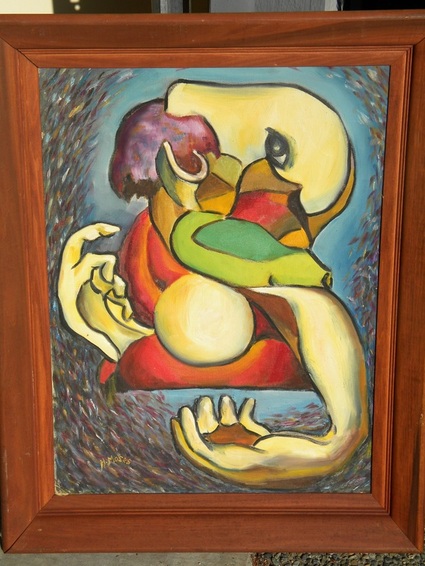Painting No. 29 The Re-Creation (Recreation)
In the summer of 1950, Herb Moses, just shy of his 21st birthday, sent his sister, Selma Bonham, a painting as a gift. Along with the painting, Herb included an essay in a plain envelope that simply read, "Painting No. 29 The Re-Creation (Recreation)." While the essay never explains why the painting was labeled No. 29, Herb eloquently expounds not only on the concepts and composition of the painting, but also about his convictions regarding the artistic process and the artist, whom he felt was generally misunderstood. This essay was Herb's attempt to offer a glimpse into the mind of the artist to illuminate the subject about which he was most passionate. This treasured piece of writing is unique among all of Herb's writings since it is the only one known to exist in which he specifically discusses art. It is even more special when one considers the innate and complex understanding Herb possessed about art, even at this young age. He also draws upon his unique vantage point to juxtapose the creative process of the scientist and the artist. For all of these reasons, Painting No. 29 The Re-Creation (Recreation) and its associated essay warrant a special place on this Web site. The following are scans of Herb's envelope and essay, along with transcriptions of each:
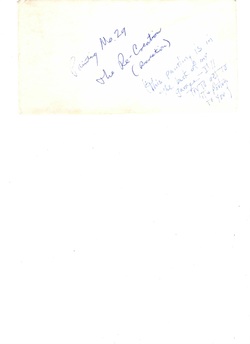
Envelope:
Painting No. 29 The Re-Creation (Recreation)
Painting No. 29 The Re-Creation (Recreation)
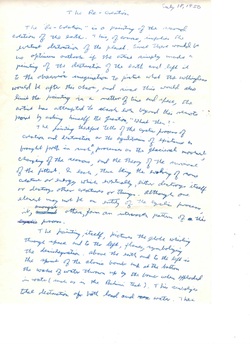
Letter:
July 18, 1950
The Re-Creation
The “Re-Creation” is a painting of the second creation of the earth. This, of course, implies the eventual destruction of the planet. Since there would be no optimum outlook if the artist simply made a painting of the destruction of the earth and left it to the observer’s imagination to picture what the nothingness would be after this chaos, and since this would also limit the painting in a matter of time and space, the artist has attempted to search even beyond this remote point by asking himself the question, “What then?”
The painting therefore tells of the cyclic process of creation and destruction or the equilibrium of existence as brought forth in such a process as the glacial movement,
changing of the seasons, and the theory of the survival of the fittest. In each, there being the evolving of some creature or energy which eventually, either destroys itself or destroys
other creatures or things. Although one element may not be an entity of the cyclic process, it, amongst others, forms an interwoven pattern of this process.
The painting, itself, pictures the globe whirling through space and to the left, flames, symbolizing the disintegration. Above the earth and to the left is the spout of the atomic bomb and at the bottom the wake of water thrown up by the bomb when exploded in water (such as in the Bikini Test). This symbolizes total destruction
of both land and water. There
July 18, 1950
The Re-Creation
The “Re-Creation” is a painting of the second creation of the earth. This, of course, implies the eventual destruction of the planet. Since there would be no optimum outlook if the artist simply made a painting of the destruction of the earth and left it to the observer’s imagination to picture what the nothingness would be after this chaos, and since this would also limit the painting in a matter of time and space, the artist has attempted to search even beyond this remote point by asking himself the question, “What then?”
The painting therefore tells of the cyclic process of creation and destruction or the equilibrium of existence as brought forth in such a process as the glacial movement,
changing of the seasons, and the theory of the survival of the fittest. In each, there being the evolving of some creature or energy which eventually, either destroys itself or destroys
other creatures or things. Although one element may not be an entity of the cyclic process, it, amongst others, forms an interwoven pattern of this process.
The painting, itself, pictures the globe whirling through space and to the left, flames, symbolizing the disintegration. Above the earth and to the left is the spout of the atomic bomb and at the bottom the wake of water thrown up by the bomb when exploded in water (such as in the Bikini Test). This symbolizes total destruction
of both land and water. There
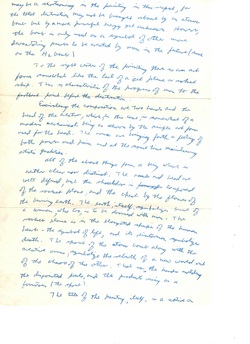
may be a shortcoming in the painting in this respect, for the total destruction may not be brought about by an atomic bomb but by a more powerful energy yet unknown. However, the bomb is only used as a symbol of other more devastating powers to be created by man in the future (such as the H2bomb.)
To the right center of the painting there is an art form somewhat like the tail of a jet plane or rocket ship. This is characteristic of the progress of man to the furthest point before the destruction.
Encircling the composition are two hands and the head of the creator, which, in this case, is somewhat of a modern mechanical being as shown by the simple art form used for the head. The arms are bringing forth a feeling of both power and pain and at the same time maintaining artistic qualities.
All of the above things form a being which is neither clear nor distinct. The arms and head are well defined, but the shoulder is composed of the rocket plane, and the chest by the flames of the burning earth. The earth, itself, symbolizes bust of a woman, who too, is to be doomed with man. The rocket plane is in the elongated shape of the human heart – the symbol of life, and its distortion symbolizes death. The spout of the atom bomb along with the creative arms, symbolize the rebirth of a new world out of the chaos of the other. That is, the hands molding the disjointed parts, and the products rising as a fountain (the spout).
The title of the painting, itself, is a satire on
To the right center of the painting there is an art form somewhat like the tail of a jet plane or rocket ship. This is characteristic of the progress of man to the furthest point before the destruction.
Encircling the composition are two hands and the head of the creator, which, in this case, is somewhat of a modern mechanical being as shown by the simple art form used for the head. The arms are bringing forth a feeling of both power and pain and at the same time maintaining artistic qualities.
All of the above things form a being which is neither clear nor distinct. The arms and head are well defined, but the shoulder is composed of the rocket plane, and the chest by the flames of the burning earth. The earth, itself, symbolizes bust of a woman, who too, is to be doomed with man. The rocket plane is in the elongated shape of the human heart – the symbol of life, and its distortion symbolizes death. The spout of the atom bomb along with the creative arms, symbolize the rebirth of a new world out of the chaos of the other. That is, the hands molding the disjointed parts, and the products rising as a fountain (the spout).
The title of the painting, itself, is a satire on
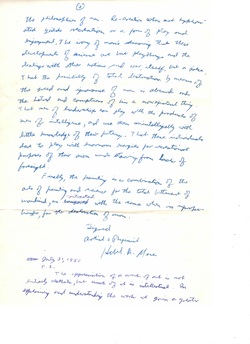
the philosophies of man. Re-creation when not hyphenated yields recreation or a form of play and enjoyment. The irony of man’s reasoning that these developments of science are but playthings and the dealings with other nations and war, itself, but a joke. That the possibility of total destruction by means of the greed and ignorance of man is absurd and the hatred and corruptness of him a non-existent thing. That men of leadership can play with the products of men of intelligence, and use them unintelligibly with little knowledge of their potency. That these individuals dare to play with enormous energies for recreational purposes of their own minds starving from lack of foresight.
Finally, the painting is a combination of the arts of painting and science for the total betterment of mankind, as contrasted with the same when in improper hands, for the destruction of man.
Signed
Artist and Physicist
Herbert A. Moses
July 31, 1950
P.S.
The appreciation of a work of art is not entirely aesthetic, but much of it is intellectual. In explaining and understanding the work we gain a greater
Finally, the painting is a combination of the arts of painting and science for the total betterment of mankind, as contrasted with the same when in improper hands, for the destruction of man.
Signed
Artist and Physicist
Herbert A. Moses
July 31, 1950
P.S.
The appreciation of a work of art is not entirely aesthetic, but much of it is intellectual. In explaining and understanding the work we gain a greater
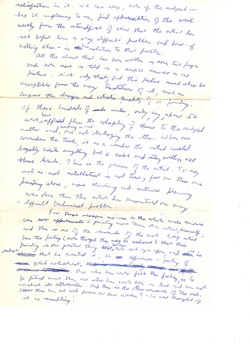
satisfaction in it. We can also, even if the subject or idea be unpleasing to us, find appreciation of the work merely from the standpoint of view that the artist has set before him a very difficult problem and here – if nothing else – is his solution to that problem.
All the above that has been written in some two pages and even more is told in a simple manner in one picture. Not only that, but his picture must also be acceptable from the many
limitations of art, such as to compose the design and artistic quality of a painting. Of these hundreds of rules, only, say, about 50 were here applied plus the adapting of these to the subject matter and keeping in mind one not destroying the other. When one considers the
task, it is a wonder the artist could legally create anything but a cube and stay within all these limits. This is the genius of the artist. To say art is not intellectual is not true, for on this one painting alone, more thinking and intense planning was done than this artist has encountered on many a difficult technical problem.
For these reasons no one in the whole wide universe can ever appreciate a painting more than the artist, himself, and this is one of the rewards of the art. Every artist has the feeling (even though he may be mediocre) that this painting is the greatest thing he has ever set eyes upon, and as he realizes that he created it, he experiences a feeling of great achievement. One who has never felt this feeling, is to be pitied more than one who has never been in love and can not conceive its attributes. And this is the other reward of the art. How then can we set prices on our works? The mere thought of it is insulting!
All the above that has been written in some two pages and even more is told in a simple manner in one picture. Not only that, but his picture must also be acceptable from the many
limitations of art, such as to compose the design and artistic quality of a painting. Of these hundreds of rules, only, say, about 50 were here applied plus the adapting of these to the subject matter and keeping in mind one not destroying the other. When one considers the
task, it is a wonder the artist could legally create anything but a cube and stay within all these limits. This is the genius of the artist. To say art is not intellectual is not true, for on this one painting alone, more thinking and intense planning was done than this artist has encountered on many a difficult technical problem.
For these reasons no one in the whole wide universe can ever appreciate a painting more than the artist, himself, and this is one of the rewards of the art. Every artist has the feeling (even though he may be mediocre) that this painting is the greatest thing he has ever set eyes upon, and as he realizes that he created it, he experiences a feeling of great achievement. One who has never felt this feeling, is to be pitied more than one who has never been in love and can not conceive its attributes. And this is the other reward of the art. How then can we set prices on our works? The mere thought of it is insulting!
